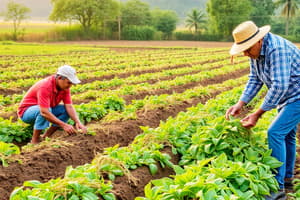Podcast
Questions and Answers
What is the primary purpose of mechanical harvesting?
What is the primary purpose of mechanical harvesting?
- To reduce labor costs and increase efficiency (correct)
- To select and harvest individual plants
- To increase labor costs
- To manually gather crops
Which type of harvesting is often used for delicate or high-value crops?
Which type of harvesting is often used for delicate or high-value crops?
- Selective Harvesting
- Manual Harvesting (correct)
- Mechanical Harvesting
- Clear-Cutting Harvesting
What is the primary purpose of selective harvesting?
What is the primary purpose of selective harvesting?
- To select and harvest individual plants or parts of plants (correct)
- To harvest entire areas of crops at once
- To harvest and process crops in one pass
- To harvest crops in strips
Which harvesting method is often used for row crops like corn and soybeans?
Which harvesting method is often used for row crops like corn and soybeans?
What type of harvesting equipment is used for grains, beans, and other dry crops?
What type of harvesting equipment is used for grains, beans, and other dry crops?
What is one of the factors that can impact harvest timing and quality?
What is one of the factors that can impact harvest timing and quality?
Why is it crucial to harvest crops at the optimal stage of maturity?
Why is it crucial to harvest crops at the optimal stage of maturity?
Why is managing pests and diseases important during harvesting?
Why is managing pests and diseases important during harvesting?
Flashcards are hidden until you start studying
Study Notes
Types of Harvesting
- Mechanical Harvesting: Uses machinery to gather crops, reducing labor costs and increasing efficiency.
- Manual Harvesting: Involves manual labor to gather crops, often used for delicate or high-value crops.
- Selective Harvesting: Involves selecting and harvesting individual plants or parts of plants, often used for fruit and nut crops.
- Clear-Cutting Harvesting: Involves harvesting an entire area of crops at once, often used for grains and other row crops.
Harvesting Methods
- Strip Harvesting: Involves harvesting crops in strips, often used for row crops like corn and soybeans.
- Block Harvesting: Involves harvesting crops in blocks, often used for fruits and vegetables.
- Single-Pass Harvesting: Involves harvesting and processing crops in one pass, often used for grains.
Harvesting Equipment
- Combine Harvesters: Used for grains, beans, and other dry crops.
- Forage Harvesters: Used for harvesting forages like hay and silage.
- Fruit and Vegetable Pickers: Used for harvesting fruits and vegetables.
- Tree Shakers: Used for harvesting nuts and fruits from trees.
Factors Affecting Harvesting
- Weather: Weather conditions like rain, drought, and temperature can impact harvest timing and quality.
- Crop Maturity: Harvesting at the optimal stage of maturity is crucial for quality and yield.
- Soil Conditions: Soil moisture, texture, and fertility can affect harvesting operations and crop quality.
- Pest and Disease Management: Managing pests and diseases is crucial to minimize crop loss during harvesting.
Harvesting Methods and Equipment
- Mechanical harvesting uses machinery to gather crops, reducing labor costs and increasing efficiency.
- Manual harvesting involves manual labor to gather crops, often used for delicate or high-value crops.
- Selective harvesting involves selecting and harvesting individual plants or parts of plants, often used for fruit and nut crops.
- Clear-cutting harvesting involves harvesting an entire area of crops at once, often used for grains and other row crops.
Harvesting Techniques
- Strip harvesting involves harvesting crops in strips, often used for row crops like corn and soybeans.
- Block harvesting involves harvesting crops in blocks, often used for fruits and vegetables.
- Single-pass harvesting involves harvesting and processing crops in one pass, often used for grains.
Harvesting Equipment
- Combine harvesters are used for grains, beans, and other dry crops.
- Forage harvesters are used for harvesting forages like hay and silage.
- Fruit and vegetable pickers are used for harvesting fruits and vegetables.
- Tree shakers are used for harvesting nuts and fruits from trees.
Factors Affecting Harvesting
- Weather conditions like rain, drought, and temperature can impact harvest timing and quality.
- Harvesting at the optimal stage of crop maturity is crucial for quality and yield.
- Soil conditions, such as moisture, texture, and fertility, can affect harvesting operations and crop quality.
- Effective pest and disease management is crucial to minimize crop loss during harvesting.
Studying That Suits You
Use AI to generate personalized quizzes and flashcards to suit your learning preferences.




